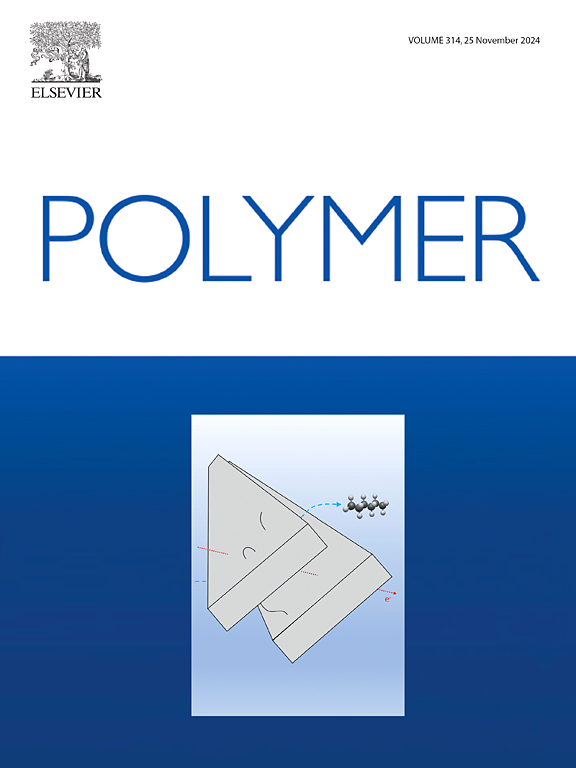Effect of the protein on the strain induced crystallization in natural rubber
IF 4.5
2区 化学
Q2 POLYMER SCIENCE
引用次数: 0
Abstract
This study systematically investigated the effects of endogenous and exogenous proteins on chain dynamics and strain-induced crystallization (SIC) in natural rubber (NR) systems through comparative analysis of NR, deproteinized natural rubber (DPNR), and centrifugal natural rubber with addition of soy protein (CNR-SP). The proton NMR transverse magnetization relaxation (T2 relaxation) measurements revealed an increase in the effective overall value of T2 () from 1560 μs for NR to 1648 μs for CNR-SP and further to 1942 μs for DPNR, demonstrating protein-induced restriction of the amorphous network mobility. Analysis of stress-strain curves indicated that endogenous proteins exhibit superior capacity in enhancing tensile stress and shear modulus compared to exogenous soy protein. The average molecular weights between adjacent crosslinking points () derived from stress-strain relations increased sequentially from 2164 g/mol (NR) to 3209 g/mol (CNR-SP) and 4652 g/mol (DPNR). Correspondingly, the crosslinking densities () determined by equilibrium swelling measurements decreased successively in the order of 4.04 x 10-4 mol/cm3 (NR), 3.76 x 10-4 mol/cm3 (CNR-SP) and 2.79 x 10-4 mol/cm3 (DPNR). These results indicated the participation of the protein in the formation of the so-called naturally occurring network, resulting in an increase in the network density. Furthermore, in situ wide angle X-ray diffraction (WAXD) experiments unraveled that the protein promotes the degree of SIC as evidenced by an earlier initiation of SIC and a higher ultimate crystallinity. This improvement in SIC directly contributes to the superior mechanical properties of NR. From a microstructural standpoint, the enhanced SIC arises from an increased network density facilitated by the involvement of protein in the naturally occurring network. Moreover, an increase in molecular orientation is observed from DPNR to CNR-SP to NR, which is indicative of a tighter amorphous network with the presence of protein. The observed tighter amorphous network is accompanied by a shorter T2 relaxation time and a smaller , which correlates directly with enhanced mechanical performance. Evidently, simple addition of soy protein cannot fully reconstruct the naturally occurring network in NR. These findings provide mechanistic insights into the structural basis of NR's superior mechanical properties, highlighting the irreplaceable role of endogenous protein arrangements in naturally occurring network formation.

蛋白质对天然橡胶中应变结晶的影响
本研究通过对天然橡胶(NR)、脱蛋白天然橡胶(DPNR)和加入大豆蛋白的离心天然橡胶(CNR-SP)进行对比分析,系统研究了内源和外源蛋白质对天然橡胶(NR)体系链动力学和应变诱导结晶(SIC)的影响。质子核磁共振横向磁化弛豫(T2弛豫)测量结果显示,NR的有效总体T2()值从1560 μs增加到CNR-SP的1648 μs, DPNR的有效总体T2()值进一步增加到1942 μs,表明蛋白质诱导了非晶网络迁移率的限制。应力应变曲线分析表明,与外源大豆蛋白相比,内源大豆蛋白在提高拉伸应力和剪切模量方面表现出更强的能力。由应力应变关系得到的相邻交联点之间的平均分子量()从2164 g/mol (NR)依次增加到3209 g/mol (CNR-SP)和4652 g/mol (DPNR)。相应的,通过平衡膨胀测定的交联密度()依次降低,依次为4.04 × 10-4 mol/cm3 (NR)、3.76 × 10-4 mol/cm3 (CNR-SP)和2.79 × 10-4 mol/cm3 (DPNR)。这些结果表明,蛋白质参与了所谓的自然发生网络的形成,导致网络密度的增加。此外,原位广角x射线衍射(WAXD)实验揭示,蛋白质促进了SIC的程度,证明了更早的SIC起始和更高的最终结晶度。SIC的这种改进直接促进了NR优越的机械性能。从微观结构的角度来看,SIC的增强是由于天然存在的网络中蛋白质的参与促进了网络密度的增加。此外,从DPNR到CNR-SP再到NR,分子取向增加,这表明随着蛋白质的存在,无定形网络更加紧密。观察到更紧密的非晶网络伴随着更短的T2松弛时间和更小的T2松弛时间,这与力学性能的增强直接相关。显然,单纯添加大豆蛋白并不能完全重建天然橡胶中的天然网络。这些发现为天然橡胶优越力学性能的结构基础提供了机制见解,突出了内源性蛋白质排列在自然形成网络中的不可替代作用。
本文章由计算机程序翻译,如有差异,请以英文原文为准。
求助全文
约1分钟内获得全文
求助全文
来源期刊

Polymer
化学-高分子科学
CiteScore
7.90
自引率
8.70%
发文量
959
审稿时长
32 days
期刊介绍:
Polymer is an interdisciplinary journal dedicated to publishing innovative and significant advances in Polymer Physics, Chemistry and Technology. We welcome submissions on polymer hybrids, nanocomposites, characterisation and self-assembly. Polymer also publishes work on the technological application of polymers in energy and optoelectronics.
The main scope is covered but not limited to the following core areas:
Polymer Materials
Nanocomposites and hybrid nanomaterials
Polymer blends, films, fibres, networks and porous materials
Physical Characterization
Characterisation, modelling and simulation* of molecular and materials properties in bulk, solution, and thin films
Polymer Engineering
Advanced multiscale processing methods
Polymer Synthesis, Modification and Self-assembly
Including designer polymer architectures, mechanisms and kinetics, and supramolecular polymerization
Technological Applications
Polymers for energy generation and storage
Polymer membranes for separation technology
Polymers for opto- and microelectronics.
 求助内容:
求助内容: 应助结果提醒方式:
应助结果提醒方式:


